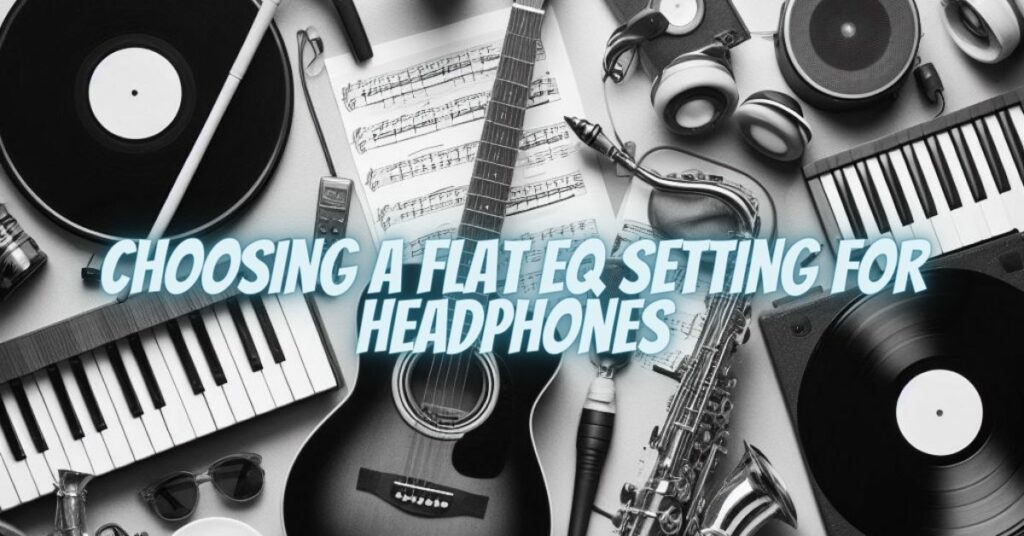Headphones are a gateway to personal, immersive listening experiences, allowing us to enjoy music, podcasts, and other audio content in the way we prefer. Among the various EQ settings available, the concept of a “flat” EQ, where all frequencies are reproduced at the same level, is often presented as the ideal for audio accuracy and neutrality. However, the question of whether a flat EQ is best for headphones is a matter of debate, hinging on individual preferences, the type of audio content, and the intended listening environment. In this article, we’ll explore the concept of a flat EQ for headphones, its advantages, potential limitations, and how personal taste and the specific nature of the audio content play a vital role in the decision-making process.
Understanding a Flat EQ for Headphones
A flat EQ for headphones involves setting all audio frequencies to the same level, without frequency boosts or cuts. The aim is to achieve a neutral and balanced representation of the sound, as if you were hearing the audio content exactly as it was recorded.
Advantages of a Flat EQ for Headphones
- Accuracy and Transparency: A flat EQ is designed to provide audio accuracy and transparency. This can be advantageous when you want to experience audio content as it was intended, without any coloration or alteration.
- Reference Listening: A flat EQ serves as a reference point for evaluating the characteristics of headphones and audio equipment. It allows audiophiles, audio professionals, and enthusiasts to objectively assess the quality and performance of their gear.
- Consistency: A flat EQ setting ensures that the sound remains consistent across different audio sources and listening environments. This is essential for making accurate comparisons between headphones and audio systems.
Limitations of a Flat EQ for Headphones
- Subjectivity: What is considered “flat” can vary among individuals. Personal preferences and the perception of neutrality can be subjective, making it challenging to determine a universally ideal setting.
- Audio Content: Different types of audio content may benefit from tailored EQ settings. Music, movies, and podcasts may require adjustments to emphasize different frequencies depending on the content.
- Listening Environment: The acoustics and ambient noise levels in your listening environment can affect how audio content is perceived. A flat EQ may not account for these external factors.
- Personal Preferences: The best EQ setting for headphones often hinges on individual listening habits and preferences. Whether you prefer more bass, a brighter treble, or a balanced sound is a highly personal choice.
When Is a Flat EQ Best for Headphones?
A flat EQ for headphones is best suited for situations where audio accuracy and transparency are essential. These include:
- Audio Production: In recording studios and post-production environments, a flat EQ setting serves as a reference point for creating audio that will translate well to various playback systems.
- Analytical Listening: Audiophiles and audio professionals who engage in critical listening or audio analysis can benefit from a flat EQ to assess audio equipment and recordings objectively.
- Reference Point: A flat EQ can be a valuable starting point for evaluating the characteristics of headphones, ensuring they faithfully reproduce the original audio source.
Personalized EQ for Headphone Enjoyment
In everyday listening scenarios, headphones serve as a means of enjoying music, movies, and podcasts on a personal level. They provide the opportunity for immersive and tailored listening experiences.
Finding the ideal EQ setting for headphones often involves considering the type of audio content you enjoy, your personal preferences, and the specific nature of your listening environment. Whether you prefer a deep bass response for electronic music, a detailed midrange for classical music, or a crisp treble for podcasts, the best EQ setting for headphones is the one that enhances your enjoyment of the audio content. The pursuit of the perfect EQ setting is deeply intertwined with your individual tastes and the kind of auditory experience you seek.
The debate over whether a flat EQ is best for headphones highlights the delicate balance between audio fidelity and personal preferences. While a flat EQ can provide accurate and transparent audio reproduction, it may not always align with the goals of enjoyable and personalized listening experiences. The best EQ setting for headphones is ultimately a matter of personal choice, the desired auditory outcome, and the type of audio content you enjoy. Whether you’re an audiophile, a casual listener, or a music enthusiast, the pursuit of the perfect EQ setting is a highly personal journey that combines the love of audio with the art of sonic perfection.


